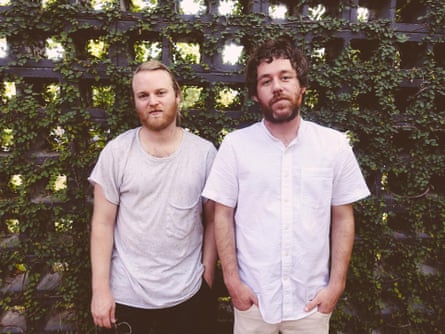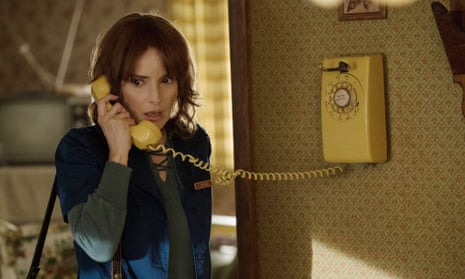On 3 July 2015, Kyle Dixon and Michael Stein got an email that changed their lives. (“The email came at 6.15pm,” jokes Dixon.) It was from Matt and Ross Duffer, twin writers and directors known as the Duffer brothers. They were making a trailer for a television show they were pitching and wanted to use a song by Dixon and Stein’s atmospheric synth band, Survive, in it. How did they know about Survive? “We have no idea,” says Stein.
When the series got snapped up by Netflix, the Duffers asked for more. “They contacted us and said: ‘Hey, are you guys still active, are you making music, would you be interested in doing, like, scoring work?’” explains Dixon. “That was enough. We wrote back immediately to kind of get an idea of what they’d have us do.”
The results of that email can be seen and heard on Netflix’s new and wildly popular, retro-inspired series Stranger Things – and in the official soundtrack, which will be released in two volumes on 12 and 19 August. The band will also release their second full-length album, RR7349, on 30 September.
Set in the 80s, Stranger Things stars Winona Ryder as the mother of a boy who goes missing under mysterious – and what turns out to be supernatural – circumstances. She sets out to find him, aided by her son’s BMX-riding friends, and a young stranger known only as 11. The drama is heightened by the unsettling, ominous and occasionally lighthearted synth work of Dixon and Stein.
The pair had long wanted to score a film and had some suitable compositions already filed away, which they sent to the Duffers. “A lot of it didn’t make it, but a lot of it laid the groundwork,” says Stein. “They picked some of what they were interested in and that kind of gave us some direction.”
They got to work almost immediately after talking with the Duffer brothers, despite knowing little about the specifics of the script. “We knew at some point in the show that someone is going to get sad, or there’s going to be a mysterious situation, so we’ll figure out a way that we’re going to come up with some sort of motif that may work,” says Dixon. “We did a lot of that work up front and some of it ended up being able to drop into place.”
Because Dixon and Stein had become involved while the series was still being pitched, they were able to come into the scoring process early. “We came on when they had two or three episodes of the script written, so they were able to share with us a general mood with storyboards and kind of a synopsis, character explanations,” says Dixon. “We got started way before there was any footage to look at.”
Apart from Ryder, the show didn’t have a cast yet either, which made writing individual themes for the characters even more challenging. “We got some preliminary sketches done for 11 and a general theme surrounding the kids and their relationship,” says Dixon.
Now based in Austin, Dixon and Stein grew up together and started making music in 2006. “Generally one of us will come up with an idea for something and then we’ll work on it together, or just kind of play music for a while and see if anything happens. [Scoring] is kind of a combination of those two things.”
When the show’s filming finally got under way, Dixon and Stein visited the set looking for inspiration, but they quickly realized they weren’t getting any work done. They returned to Austin to lose themselves in the world of Stranger Things, but from a distance, using scripts and conversations with the Duffer brothers to craft their motifs and musical themes for each character.
“We touched on some of the more pivotal themes and ideas, the structure of the storyline, the characters, the Upside-Down, and the entity monster,” added Stein. “[There was music for] different groups like the young kids, teens with the kind of 80s romance. Then obviously there’s horror and pretty dark stuff in there too, and we just started to encompass the fact that the show has a really broad spectrum of emotions.”

Visually, Stranger Things has drawn comparisons to ET, but according to Stein and Dixon, musically it couldn’t be more different. “That’s kind of a huge, whimsical orchestral,” said Dixon, noting that occasionally the score, by John Williams, clashes with what’s happening on screen. (However, they are huge fans of Williams, even having a song named after him.)
While the series is set in the 80s, the Stranger Things themes take inspiration from the work of John Carpenter, who wrote the music for as well as directed classic 70s horror movies such as Halloween; and Tangerine Dream, who scored films such as Firestarter, Sorcerer and The Keep, which Survive have cited as major influences.
“I don’t want to say we’re necessarily going for that style 100%, but we use a lot of the same equipment they do and we’re doing similar type of work to what they did,” says Stein. Their score, however, occupies a modern niche that is wholly their own, zooming between the sparse, the haunting and fanciful, with the sensibility of current artists like Oneohtrix Point Never, Boards of Canada and Autechre.
For Stein and Dixon, being compared to their heroes is amazing. “I was just trying to imagine what I was doing 10 years ago musically,” said Stein. “That was preposterous, insane, like not even music at all. And now …” Dixon finished his thought: “It still hasn’t sunk in.”

Comments (…)
Sign in or create your Guardian account to join the discussion